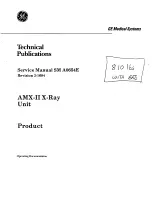
7
Instruction Booklet
IB022003EN
Effective April 2018
Revision #3
Instructions for installation, operation, and
maintenance of Type MVS-ND, metal-enclosed
switchgear assemblies: 4.76 kV or 15.0 kV class
EATON
www.eaton.com
Step 1:
Obtain the tie bolt hardware located in the shop order
detail box . All tie bolt hardware is installed from the right-
hand sidewall of the left-hand vertical section into the left-
hand sidewall of the right-hand vertical section .
Step 2:
Open the front door, remove screen barriers and roof
sheets . There are (18) 0 .88 in . (22 .35 mm) diameter
clearance holes in each vertical section . Install a ¼-20 self-
tapping screw through each of the clearance holes and
secure into the left-hand sidewall of the right-hand vertical
section .
Step 3:
Make the main and ground bus connections using the
links and hardware furnished . The busbar is silver-plated . To
ensure a proper electrical connection, care should be taken
to protect the plating from damage . DO NOT use joint
compound .
CAUTION
CLEANING BUS JOINTS WITH ABRASIVE OR CHEMICAL CLEANSERS MAY
REMOVE PLATING, WHICH MAY CAUSE JOINT OVERHEATING. TO CLEAN
THE SURFACES, WIPE THEM WITH CLEAN, DRY CLOTH.
Step 4: Bolted connections should be tightened to the torque
values given in MVS-ND switchgear bolt tightness for bus
connections on Page 13 .
Installation of roof caps on outdoor units
Roof caps are necessary to complete the roof of all outdoor
MVS-ND switchgear assemblies . Those not factory installed are
shipped on the switchgear in a “shipping” position or cartons that
are shipped separately .
The following procedure and accompanying figures detail the work
to be done to install each cap .
Step 1: Remove the lifting lugs from the MVS-ND switchgear
assembly .
Step 2: Place a roof cap (intermediate or end) in position . Install
the hardware on vertical end surfaces to hold the roof cap
in place .
Figure 3. Installation of Roof Caps on Outdoor Units.
Step 3: Continue this procedure until all roof caps have been
installed .
Connection of Type MVS-ND switchgear to the transformer
Physical connection
Indoor assemblies, dry type, cast coil type, or liquid filled
type transformers
Holes are pre-drilled in the side of the MVS-ND structure to match
the holes provided in the transformer case . Hardware is provided
in the MVS-ND switchgear where it will be connected to the
transformer . Remove this hardware and retain it for fastening the
switchgear to the transformer .
Move the MVS-ND switchgear to match the holes on the side that
will face the transformer to the matching holes in the transformer
case . Minor misalignment may be corrected with a tapered guiding
rod of some kind . Insert the hardware and tighten . Use extreme
caution in moving the MVS-ND switchgear to prevent damage .
Outdoor throat connection, liquid filled transformers
Step 1: Remove the sealing ring flange from MVS-ND switchgear
throat and set it aside .
Step 2: The switchgear and transformer should be brought
together to give a spacing of approximately 0 .5 in .
(12 .7 mm) between throat flanges .
Step 3: Apply the double adhesive tape supplied with MVS-ND
switchgear to outside surfaces of both flanges .
Step 4: Press felt supplied with MVS-ND switchgear into place on
adhesive tape .
Step 5: Reinstall sealing ring removed in Step 1 .
Medium voltage electrical connections
Connection by cables supplied with type MVS-ND switchgear
or transformer
•
The supplied cables are NOT factory pre-cut to the proper length .
The installer MUST cut the cables to fit .
•
Factory cables are unshielded . For 15 kV applications, they must
be properly separated from each other, from all grounded metal
parts, and from the transformer bushings/terminals of other
phases . For 4 .76 kV applications, it is only necessary to install
cables so they will not be damaged from sharp edges, points, etc .
•
Phasing of main conductors in type MVS-ND switchgear conforms
to industry standards, which is 1, 2, 3, front to rear, top to bottom,
and left to right at connection points unless otherwise noted
on the drawings . The installer is responsible for maintaining
continuity of phasing throughout the system .
•
Lugs are provided with the switchgear for terminating the
cables to the transformer bushings/terminals or to the MVS-ND
switchgear terminals .
Connection by busbar
•
Splice plates and hardware are furnished with the MVS-ND
switchgear . The transformer manufacturer supplies a flexible
connector if the transformer is a dry type or cast coil . If the
transformer is liquid filled type, MVS-ND provides the flexible
connector .
•
Busbar is plated . To ensure a proper electrical connection, care
should be taken to protect the plating from damage . Refer to
Procedures for joining MVS-ND enclosures at shipping splits on
•
All copper connections should be tightened according to the
specifications given in MVS-ND switchgear bolt tightness for bus
connections on Page 13 .
Connections to AMPGARD medium voltage motor control
center (MCC)
Step 1: Holes are pre-drilled in the side of the MVS-ND switchgear
structure to match holes provided in the AMPGARD MCC .
Bolt the units together using hardware furnished with the
MVS-ND switchgear .
Step 2: Make the bus connections as detailed in Connection
by busbar .






































